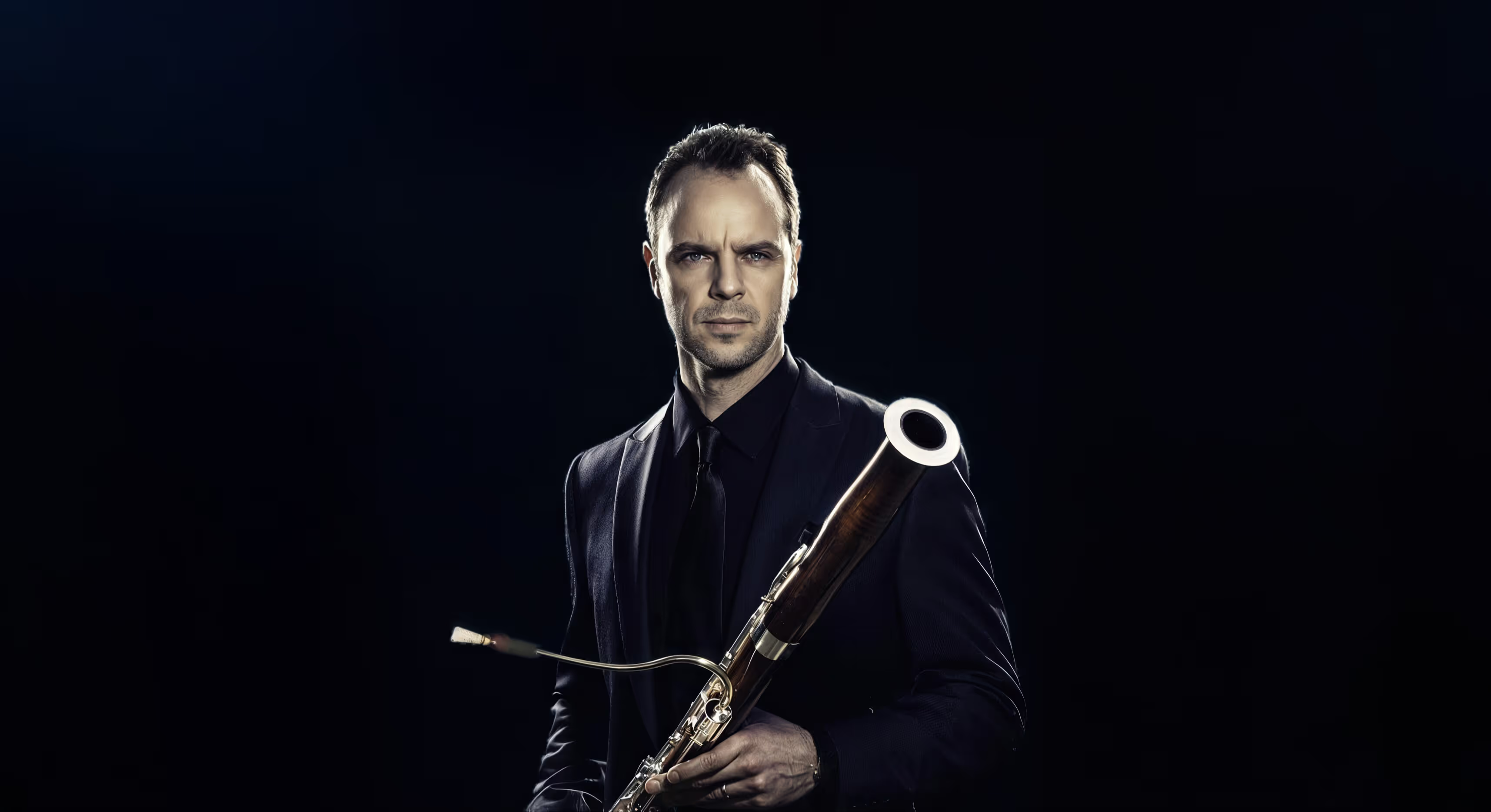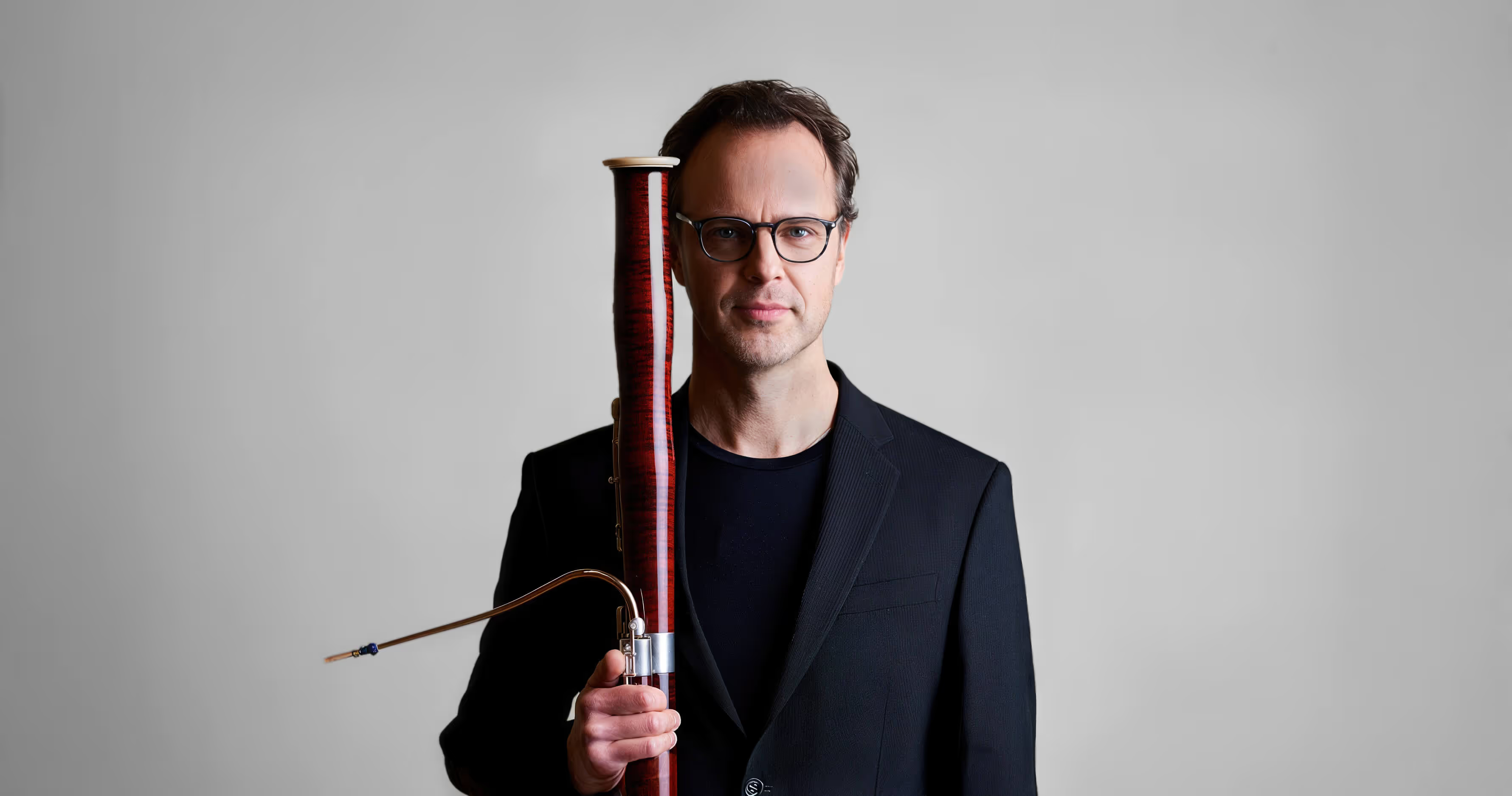Kuuskmann has redefined what a bassoon soloist can achieve on the world stage. A multiple Grammy-nominated recording artist and passionate educator, he bridges the cultural gap between his Baltic roots and his American home, captivating audiences who never imagined a bassoon could command center stage.

From Tallinn to New York: Early Life and Musical Roots
Born in Tallinn in 1971 during the Soviet era, Kuuskmann came of age just as Estonia regained its independence. He began his musical journey on piano and clarinet but fatefully picked up the bassoon at age 15, drawn to its versatile low voice. After graduating from Tallinn Music High School, he continued on under full scholarship at the San Jose State University in Dr. Vernon Read’s bassoon class while studying privately with Rufus Olivier whom he considers as one of his main influences to bassoon playing. After two years in San Jose he earned full scholarships to Yale University School of Music followed by New York’s Manhattan School of Music (and declined a full ride to Juilliard School and Salzburg Mozarteum), where he honed his craft under legendary bassoon mentors Stephen Maxym and Frank Morelli. This transatlantic leap in the early 1990s set the stage for Kuuskmann’s remarkable career in the United States. “It’s always good to be back home in Estonia,” he admits after 32 years abroad, but his journey from a small Baltic nation to America’s top music institutions imbued his artistry with a unique cross‑cultural perspective.

Carving Out a Trailblazing Solo Career
Kuuskmann belongs to the rare breed of bassoonists who step out of the orchestra’s back row and into the spotlight. Armed with a commanding stage presence and “stunning” virtuosity, he became a tour de force on his instrument. Early on, he co‑founded New York City’s avant‑garde Absolute Ensemble (led by Kristjan Järvi) as its solo bassoonist and freelanced with renowned groups like the Orpheus Chamber Orchestra and New Jersey Symphony. By the 2000s Kuuskmann was headlining concert halls around the globe as a concerto soloist.
He has appeared with leading ensembles such as the Estonian National Symphony Orchestra, Estonian Festival Orchestra, Orchestre de la Suisse Romande, the MDR Leipzig Radio Symphony, and the American Composers Orchestra, under star conductors like Neeme, Paavo and Kristjan Järvi, Risto Joost, Robert Spano among many others. From Carnegie Hall in New York to the Kennedy Center in Washington, D.C., to major venues in Europe and Asia, his bassoon’s rich voice has enthralled audiences worldwide.
One of Kuuskmann’s hallmarks is pushing boundaries for his instrument. Fourteen bassoon concertos have now been written expressly for him—an unprecedented tally—including works by Estonian giants Erkki‑Sven Tüür, Eino Tamberg, and Tõnu Kõrvits, as well as Americans Christopher Theofanidis and David Chesky. Most recently, Estonian‑American 2025 Rome Prize winning composer composer, Lembit Beecher unveiled a new concerto in 2024, a co-commission of the Redlands Symphony Orchestra and A Far Cry Ensemble which Kuuskmann premiered with the Redlands SO under Ransom Wilson in April of 2025 and is scheduled to do the East-Coast premiere and a commercial recording with the Grammy‑winning chamber orchestra A Far Cry in April 2026.
In 2008 the New York Philharmonic invited him to perform Luciano Berio’s notoriously demanding Sequenza XII for solo bassoon; his feat of “virtuoso technique with super‑human breath control” left critics in awe. And perhaps no piece shows his flair better than Michael Daugherty’s whimsical concerto Dead Elvis: Kuuskmann has performed this rock‑and‑roll‑inspired piece—complete with Elvis costume—nearly 50 times worldwide, earning a German Record Critics’ Prize for its 2001 recording.
Career Highlights
- Grammy Recognitions: Multiple nominations, including a 2007 nod for Chesky’s Bassoon Concerto and a 2017 nomination for Theofanidis’ concerto, both written for him.
- Champion of New Music: Premiered 15 major concertos, most recently Lembit Beecher’s 2025 work, expanding the bassoon repertoire like no one before.
- Critical Acclaim: The International Double Reed Society extols his “remarkable technique… you‑name‑it, he does it all,” confirming his impact on the double‑reed world.

Beyond Classical: Versatility and Creative Collaboration
Firmly rooted in classical tradition, Kuuskmann is an artist without borders. Jazz icon John Patituccicomposed a soulful Caprice No.1for him; he has jammed with legends like Joe ZawinulandGerry Mulligan, proving that a bassoon can swing. He has a multi-genre duo with pianist Kristjan Randalu (Schubert Voyage on Berlin Classics). Kuuskmann explores Brazilian grooves with pianist Jovino Santos Neto (Retratos on Audiophile Records) and fused Tibetan chant with electronics on the album The Path of Mantra
A beloved anecdote underscores his stature: in 2010, Estonia’s most celebrated composer Arvo Pärt personally sat in the Estonia Radio control room to remaster Kuuskmann’s track of “Spiegel im Spiegel,” insisting the bassoon be brought forward in the mix. “Makes a great story every time,” Kuuskmann laughs.
Whether amplifying avant‑garde scores or intimate chamber pieces, he “transcends the boundaries” of classical bassoon by emphasizing a human, vocal expressiveness. In his hands, the bassoon sings any musical language.
Mentor, Professor, and Cultural Ambassador
Kuuskmann began teaching in the late 1990s in New York’s Mannes School of Music Preparatory School followed by the Manhattan School of Music's Contemporary Performance Program and later joined the faculty of Cornish College of the Artsin Seattle. Today, he is Associate Professor of Bassoon at the University of Denver’s Lamont School of Music, attracting students eager to absorb his boundary‑pushing philosophy. Since 2010 he has been an active artist-representative of a German bassoon manufacturer, Bernd Moosmann Bassoons, where he has advised the development of several of their latest professional bassoon models.
He bridges Estonia and the U.S. as one of the principal bassoonist of the Estonian Festival Orchestra under Paavo Järvi, woodwind coach for the Baltic Sea Philharmonic, and through frequent festival appearances back home. In2021, Icelandic composer Páll Ragnar Pállson wrote PLAY—a concerto inspired by Kuuskmann's life story, a co-commission of the Estonian National Symphony Orchestra and Finland’s Kymi Sinfonietta (both under conductor Olari Elts) and premiered in 2022, while the Iceland premiere of PLAY in the Harpa occurred in January of 2025 with the Iceland Symphony Orchestra under Daniel Bjarnason. In2022 he became the first‑ever Artist‑in‑Residence of the Tucson Symphony Orchestra.
Despite decades abroad, Kuuskmann remains proudly connected to his roots. Performing Tõnu Kõrvits’s “Rains Songs to the Rainbow" in 2023 (premiered in 2015 with the Tallinn Chamber Orchestra under Risto Joost), he admitted: “It’s always good to be back home in Estonia.” It was a full‑circle moment for an artist who has journeyed so far.
Legacy of a Northern Virtuoso
At 54, Martin Kuuskmann stands at the pinnacle of a singular career. He has shattered preconceptions about the bassoon, proving that this mellow woodwind can dazzle and inspire across continents. Whether in tails at Carnegie Hall or decked out as Elvis, Kuuskmann brings passion, humor, and humanity to his music.
For Baltic‑Nordic creative communities—and listeners new to classical music—his artistry offers a thrilling discovery. The voice of a small nation, sounding through a bassoon’s bell, now resonates worldwide with remarkable power and originality. In the hands of this Estonian virtuoso, the bassoon truly sings with a northern voice that will not soon be forgotten.













.png)
.png)
.png)
